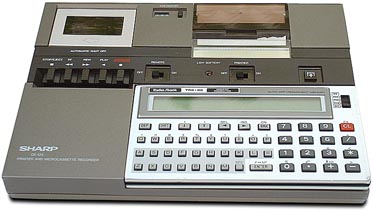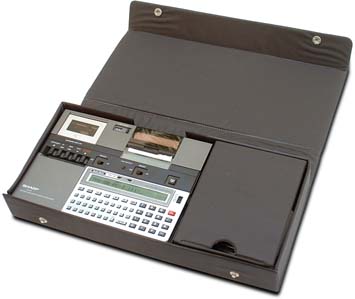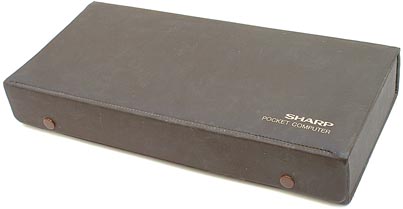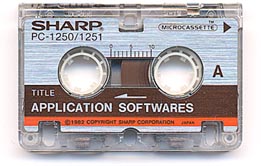|
|
|---|
| TRS-80 PC-3 Pocket Computer |
| Released: | June 1983 |
| Price: | US $99.95 |
| Weight: | 3.8 ounces |
| CPU: | SC 61860 |
| RAM: | 4K (1.4K user) |
| Ports: | none |
| Display: | 24 X 1 text LCD display |
| Power: | 'button' batteries |
| Storage: | Optional audio cassette |
| Peripherals: | Optional printer |
| OS: | BASIC in ROM |
| |
|---|
|
|
|

Truly a shirt-pocket-sized, fully-functional programmable computer, the TRS-80 PC-3 was actually built by Sharp
and is nearly identical to the Sharp PC-1251 of 1982.
As the successor to the PC-1 and PC-2, the PC-3 is the
smallest and lightest of the early TRS-80 pocket computers.
For additional capabilities, the printer/cassette interface can be attached. It has a 24 characters-per-line
thermal printer, a cassette input/output interface, and internal rechargeable batteries which also supply power
to the computer, extending the life of the PC-3 batteries.


Since the TRS-80 pocket computers are really re-badged Sharp pocket computers, the TRS-80 units work well
with the Sharp peripherals. Seen here is the TRS-80 PC-3 installed in the Sharp CE-125 Docking Station, with built-in Micro-Tape drive and Printer.


|
|---|
History of the Radio Shack Computers |
- 1921: - Radio Shack begins as a one-store retail and mail-order company catering to
ham operators and electronics buffs.
- 1963: - Charles Tandy buys the chain of stores, and within two years turned a $4 million dollar
loss into a $20 million dollar profit.
- 1977: August - Radio Shack announces the TRS-80 Model I microcomputer for US$600.
- 1977: September - One month after launching the TRS-80, 10,000 are sold.
- 1979: May - Tandy/Radio Shack announces the TRS-80 Model II.
- 1979: October - Radio Shack begins shipping the TRS-80 Model II to users.
- 1980: July - Radio Shack introduces the TRS-80 Model III, priced from US$700 to US$2500.
- 1980: July - Radio Shack introduces the TRS-80 Color Computer, and sells for US$400.
- 1980: July - Radio Shack introduces the TRS-80 Pocket Computer. Price is US$230.
- 1981: January - Radio Shack ceases production of the TRS-80 Model I, and recalls units from the
US market, due to failure to meet new FCC radio-frequency interference regulations.
- 1982: January - Radio Shack introduces the TRS-80 Model 16, with 8-inch floppy drives, and
optional 8-MB hard drive.
- 1982: January - Radio Shack introduces the TRS-80 Pocket Computer, Model PC-2, for US$280.
- 1983: March - Radio Shack announces its TRS-80 Model 100 portable computer. Price is US$799 for
8KB version, to US$1134 for the 32KB version.
- 1983: May - Radio Shack introduces the TRS-80 Model 4, for US$2000.
- 1983: June - Radio Shack introduces the TRS-80 PC-3, for US$99.95.
- 1983: October - Tandy/Radio Shack announces the "transportable" TRS-80 Model 4P, for US$1800.
- 1983: Radio Shack introduces the TRS-80 Pocket Computer, Model PC-4, replacing the PC-1, for US$70.
- 1983: Tandy releases the TRS-80 Model 2000, which uses the Intel 80186 microprocessor.
- 1983: Radio Shack unveils the TRS-80 Model 12 at the CP/M '83 Show. Price is US$3200.
- 1985: March - Radio Shack introduces the Tandy 6000 multiuser system. It features Z80A and 68000
processors, 512 KB RAM, 80x24 text, graphics, 1.2-MB 8-inch
disk, optional 15 MB hard drive, TRS-DOS, or XENIX 3.0. It supports up to 9 users.
Source:
Chronology of Events in the History of Microcomputers
| |
|---|
|
Return to the Obsolete Technology Homepage

Copyright 2024
This page last updated on 05/08/2016 01:06:14
All logos and trademarks on this site are property of their respective owner.
|





